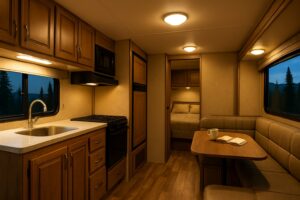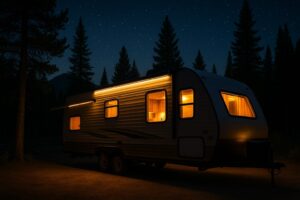Upgrading to LED Lights in Your RV: A Bright Idea for Smart RVers
Why Switch to RV LED Lights?
 If you’re still running incandescent or fluorescent bulbs, you’re paying in battery drain, heat, and hassle. RV LED lights deliver the same or better brightness while using far less energy and producing much less heat—perfect for boondocking or long campground stays.
If you’re still running incandescent or fluorescent bulbs, you’re paying in battery drain, heat, and hassle. RV LED lights deliver the same or better brightness while using far less energy and producing much less heat—perfect for boondocking or long campground stays.
Top benefits at a glance
Energy efficiency: LEDs can cut power draw by 70–85%, stretching battery life when you’re off-grid.
Longevity: Typical ratings of 25,000–50,000 hours vs. ~1,000 for incandescents.
Cooler operation: Less heat buildup under lenses and cabinets, reducing fire risk and cabin temps.
Versatile look: Choose warm (2700–3000K) for cozy spaces or neutral/cool (4000–5000K) for task lighting.
Real savings: Slightly higher upfront cost, but fewer replacements and less generator time quickly pay you back.
Boondocker’s bonus: Imagine an evening near Virginia City’s ghost town or along the Beaverhead near Dillon—LEDs keep your lights on for hours without hammering your batteries or forcing the generator to hum through the crickets.
Quick Power Math (So You Feel the Difference)
Before (Incandescent 921s):
10 bulbs × 18W = 180W total load → ~15A at 12V.
With ~50Ah usable from a 100Ah lead-acid bank, that’s ≈3.3 hours of light.After (LED replacements @ 3W):
10 bulbs × 3W = 30W total load → ~2.5A at 12V.
Same usable 50Ah = ≈20 hours of light.
That’s about 6× the runtime for the same brightness. Add solar and you’ll often break even on daily usage without firing the generator.
Know Your Bulbs (So You Buy Once)
Most interior fixtures in RVs are 12V DC. Match the base and voltage.
921 / T10 wedge: Common dome/ceiling bulb. Look for “921 LED 12V.”
G4 bi-pin (back- or side-pin): Reading/puck lights. Check pin orientation and board style.
BA15s (1156 single-contact bayonet): Porch, step, or exterior lamps—ensure proper brightness.
Fluorescent T5/T8 (12V fixtures): Convert with an LED retrofit kit; often bypassing the ballast is best.
Strips (12V LED): Under-cabinet, toe-kick, or awning accents—easy, flexible, and dimmable.
Pro tip: Snap a photo of the socket and bulb and bring it to the counter (e.g., Highway 93 RV in Victor). Matching is faster and prevents returns.
Lumens, Color Temperature & CRI (How to Get the Look You Want)
Lumens = brightness (not watts).
400–600 lm: Bedroom, dinette, ambient.
800–1,000+ lm: Kitchen, desk, work zones.
Color temperature (CCT):
2700–3000K: Warm, relaxing—great in living/bedroom areas.
3500–4000K: Neutral, balanced—good all-purpose.
5000K: Crisp task light—use sparingly to avoid a sterile vibe.
Dimming, Flicker & Compatibility
Buy dimmable LEDs if you use dimmers. Not all 12V LEDs dim well, especially with older PWM dimmers.
Flicker/banding (annoying to eyes and cameras) usually means a cheap driver or mismatched dimmer—upgrade either the lamp or the dimmer.
Polarity matters on many 12V LED lamps. If it doesn’t light, flip it 180° or swap leads (safely).
Step-by-Step: How to Upgrade to RV LED Lights
Audit every fixture
Note location, base type (921, G4, BA15s, etc.), desired brightness, and color temp. Prioritize high-use areas first.Choose quality lamps
Look for 12V DC, dimmable (if needed), rated for 11–15V automotive/RV ranges, and a decent warranty. Standardize color temps across zones for a unified look.Gather simple tools
Phillips screwdriver, trim tool, non-contact voltage tester, a small multimeter, and a dab of dielectric grease for bayonet contacts.Power down
Disconnect the battery or use the 12V master switch before opening fixtures.Swap and test
Replace bulbs zone by zone, test before reinstalling lenses. If a lamp is dark, check polarity or gently tension wedge contacts.Add dimmers & scenes
Upgrade to LED-compatible dimmers. For strips, inline controllers (remote/Bluetooth) make it easy to set “Evening,” “Movie,” or “Work” levels.
Fluorescent Conversions (T5/T8)
Older 12V fluorescent fixtures waste energy and flicker with age. A ballast-bypass LED kit usually wins for efficiency and reliability.
Remove power, open fixture, identify and remove the ballast.
Follow the kit diagram to correctly feed the LED tube(s).
Secure wiring, close the lens, and test. Enjoy instant-on, silent, efficient light.
Exterior & Safety Lighting Upgrades
Porch/step: Wide-beam warm white for depth perception; motion sensors are handy.
Storage bays: Low-glare LEDs with magnetic or touch switches keep hands free.
Marker/brake: Choose bright, compliant assemblies; visibility = safety.
Backup/camera assist: A bright, focused white LED improves camera clarity at night.
Common Problems (And Fast Fixes)
Doesn’t light? Polarity—flip or rotate.
Shimmers when dimmed? Non-LED dimmer or cheap driver—swap one or the other.
Radio static when on? EMI from a bargain driver—use higher-quality LEDs or add ferrite chokes to leads.
Uneven color room-to-room? Mixed CCTs—standardize on 2700–3000K for living/bedrooms, 3500–4000K for task.
Cost, ROI & Comfort Wins
Expect $5–$15 per interior lamp and more for exterior assemblies. Returns come from fewer replacements, less generator time, cooler cabins, and massive battery runtime gains. Even on shore power (say, at Southside in Dillon or Ennis RV Village), RV LED lights trim kWh use and heat, making summers more comfortable.
Safety & Disposal
Always disconnect 12V before working.
Use the correct voltage lamp (12V vs. 120V).
Recycle fluorescents (contain a small amount of mercury).
Recycle LEDs where available; avoid e-waste in landfills.
The Smart RVer Takeaway
 Upgrading to RV LED lights is the easiest, highest-impact electrical project you can do. You’ll see the difference on night one: brighter spaces, calmer temperatures, and batteries that last. Start with your most-used fixtures, match color temps, add LED-rated dimmers, and then tackle exterior and accent lighting. If you want help matching sockets or dialing in lumens, swing by Highway 93 RV in Victor, Montana—we’ll get you the right parts the first time.
Upgrading to RV LED lights is the easiest, highest-impact electrical project you can do. You’ll see the difference on night one: brighter spaces, calmer temperatures, and batteries that last. Start with your most-used fixtures, match color temps, add LED-rated dimmers, and then tackle exterior and accent lighting. If you want help matching sockets or dialing in lumens, swing by Highway 93 RV in Victor, Montana—we’ll get you the right parts the first time.
Do LEDs still get hot?
Less than incandescents, but drivers/chips make some heat—don’t cram high-watt boards into sealed micro-lenses
Can I use household LEDs?
Only on 120V AC circuits. Most RV interior lights are 12V DC—buy 12V-rated LEDs for those.
How many lumens do I need?
400–600 lm for ambient, 800–1,000+ lm for task. Beam angle matters—wide beams reduce hotspots.